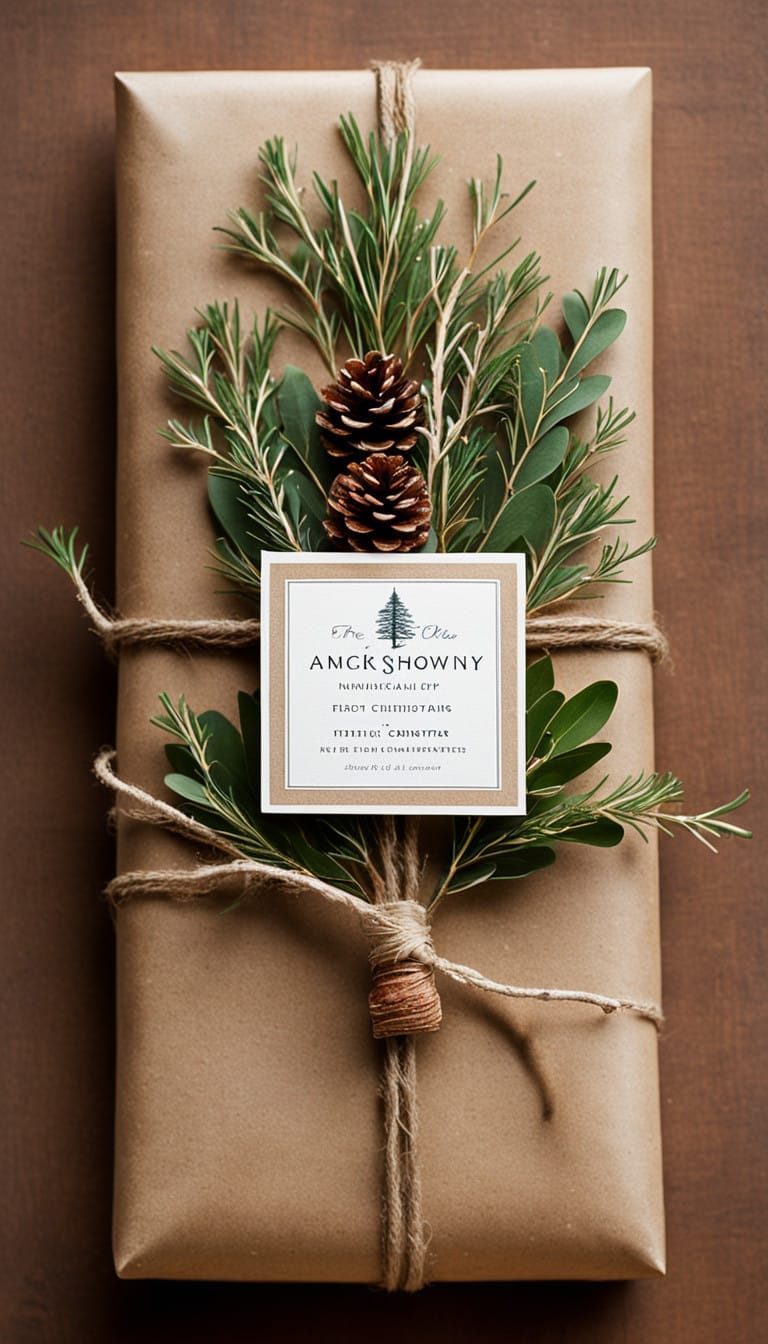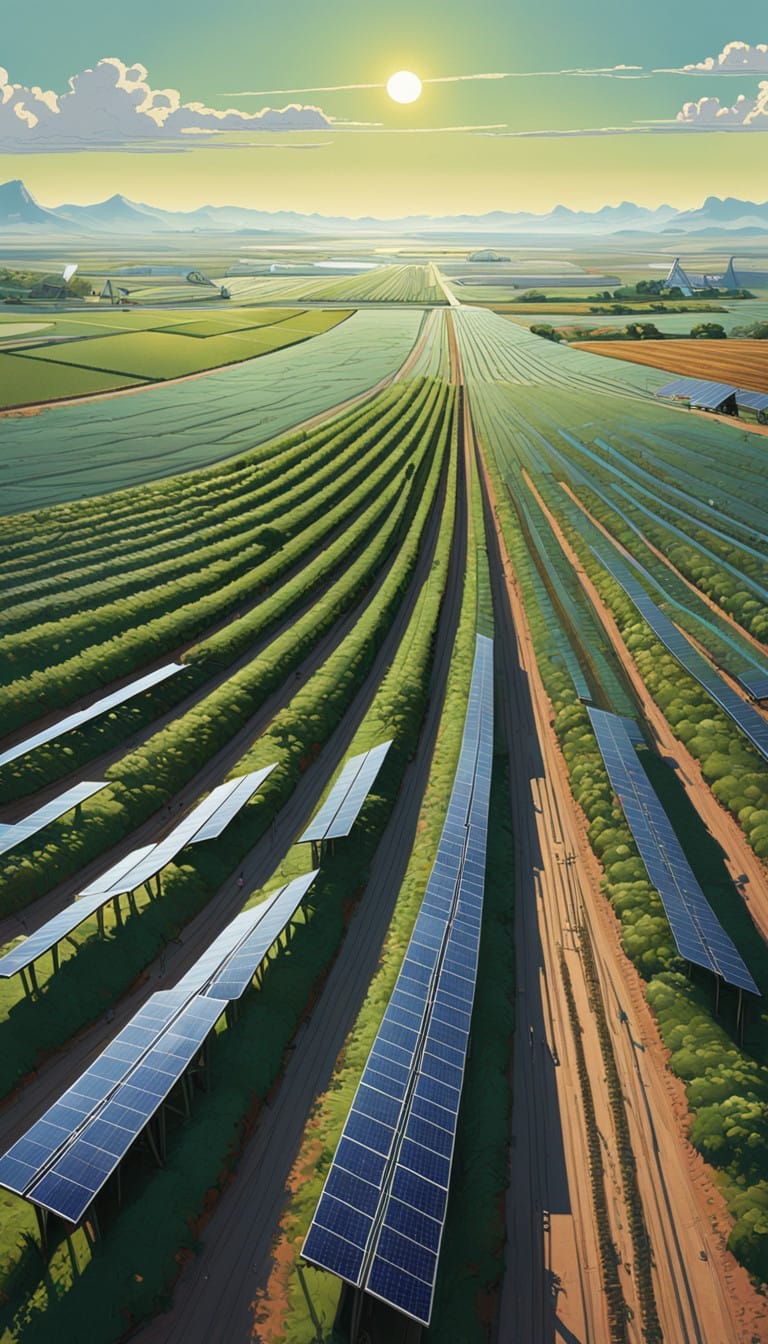

The holiday season is upon us, and with it comes the joyous atmosphere of Christmas — a time for giving, gathering, and generous feasting. However, as we embrace the festive spirit, it’s crucial to remember the impact our celebrations can leave on the planet. This year, why not aim for a merrier Christmas for both your loved ones and the Earth? Let’s delve into creative ways to make your holiday season as eco-friendly as possible without dampening the festive spirit!
First things first: the Christmas tree. It’s the heart of the festive decor, but did you know that traditional artificial trees can have a sizeable carbon footprint due to their manufacturing process? Instead, consider these alternatives:
Choose a Real Tree: Live trees are often grown specifically for the holiday season, which means they can be a sustainable option if sourced locally. After the festivities, many tree farms offer recycling programs, such as turning your tree into mulch for local parks or gardens.
Rent a Tree: In some areas, you can rent a potted tree that can be returned after the holidays. This way, you can enjoy the beauty of a real tree without causing long-term harm.
Get Creative: If you want to eschew the traditional tree altogether, think outside the box! You could create a festive tree shape using branches, driftwood, or even books. The only limit is your imagination!
When it comes to decorating your home, there are countless ways to add a festive touch without relying on single-use plastic ornaments:
DIY Decorations: Crafting your decorations can be a fun family activity. Use natural materials such as pinecones, dried fruits, cinnamon sticks, and even popcorn strings to create a rustic feel. Embrace the charm of homemade decorations that can be stored and reused year after year.
Reuse and Repurpose: Before you head out to buy new decorations, take a look around your home and see what you can repurpose. Old Christmas cards can be turned into gift tags, while last year’s decorations could get a refresh with a little creativity.
Natural Elements: Bring the beauty of nature indoors with holly, mistletoe, and evergreens. Not only do they smell delightful, but they also add a touch of authenticity to your holiday decor.
Gift-giving can sometimes border on excessive, leading to heaps of wasteful wrapping and unwanted items. This holiday season, shift your focus towards thoughtful, sustainable gifts:
Consider Experiences Over Things: Instead of material presents, consider gifting experiences — think cooking classes, spa days, or tickets to concerts. Memories often hold more value than physical items.
Shop Local and Handmade: Supporting local artisans helps reduce carbon footprints associated with shipping products long distances. Plus, handmade gifts often carry a personal touch that store-bought items may lack.
Eco-Friendly Wrapping: When it comes to wrapping, forego standard gift wrap that ends up in the bin. Instead, use recycled paper, fabric scraps, or even pages from old magazines. The art of furoshiki — the Japanese technique of wrapping gifts in cloth — not only looks elegant but is also beautifully eco-friendly.
Food plays a central role in many holiday celebrations, and there are several ways to make your Christmas dinner eco-friendlier:
Go Plant-Based: Consider including more plant-based dishes in your holiday feast. Not only are they often more sustainable, but they can also be healthier! Think hearty veggie roasts, seasonal salads, and vibrant side dishes.
Source Local and Organic Produce: Buy your ingredients from local markets or organic farms. This helps support your community and results in fresher, more nutritious food. Plus, it reduces the carbon footprint associated with transporting food over long distances.
Waste Not, Want Not: Plan your meals thoughtfully to minimise food waste. Use leftovers creatively in subsequent meals or consider composting any food scraps. Many recipes can transform yesterday’s feast into tomorrow’s delightful dish!
Twinkling Christmas lights can really elevate the festive mood, but traditional bulbs can use a significant amount of energy. Here’s how to illuminate your home sustainably:
Use LED Lights: If you’re not using them already, switch to energy-efficient LED lights. They consume significantly less energy and last longer than traditional incandescent bulbs.
Solar Options: When possible, opt for solar-powered lights. They charge during the day and delight your evenings without draining your electricity.
Natural Glow: Consider using candles made from natural materials like beeswax or soy instead of paraffin. Besides being eco-friendly, they can create a warm and inviting atmosphere.
If you’re heading out to visit family or friends over the holidays, travel can significantly impact your carbon footprint. Here are some tips to mitigate that:
Carpool or Use Public Transport: If you can, try carpooling with friends or family to reduce the number of vehicles on the road. Alternatively, consider taking public transportation, as it’s often more efficient than individual car journeys.
Offset Your Emissions: If flying or taking a long car trip is unavoidable, look into carbon offset programs. These initiatives allow you to invest in projects that reduce greenhouse gas emissions in other areas, such as reforestation or renewable energy ventures.
Finally, the holiday season is all about traditions. Why not create some new eco-friendly traditions that can be cherished for years to come? This could include:
Nature Walks: Make it a family ritual to take a nature walk during the holidays. Not only does it get everyone outside and active, but you can also gather natural decorations for home use.
Volunteering: Spend some time giving back to your local community or environment. Volunteering at shelters, food banks or environmental cleanup projects not only spreads joy but reinforces the spirit of giving.
As the holidays draw to a close, don’t let carelessness overshadow your eco-friendly efforts. Ensure you recycle or appropriately dispose of materials, from wrapping paper to food scraps. Many areas even have specific recycling guidelines for holiday materials, so make sure to check local resources.
Making family traditions sustainable doesn’t mean sacrificing the joy of the season. Instead, it’s about embracing creativity, thoughtfulness, and a connection to our planet. So this year, as you hang those twinkling lights and wrap those carefully curated gifts, remember: that every small change contributes to a larger goal of creating a more sustainable future.
Let’s celebrate this Christmas with love, laughter, and care for the Earth we call home. After all, nothing enhances the joy of the season more than knowing you’re helping to protect it for future generations. Happy holidays! 🎄🌍✨


Hey there, friends! Today, let’s chat about something that’s really lighting up the scene in sustainable living — solar agriculture. If you’ve ever pondered how we can nourish both people and our planet at the same time, this might just be the solution we’ve been waiting for. Imagine harnessing the power of the sun to grow our food while simultaneously generating renewable energy. It sounds like something out of a futuristic novel, but it’s happening right here, right now!
So, what exactly is solar agriculture? In simple terms, it involves integrating solar panels into farming practices. This means farmers can generate clean energy while cultivating crops or raising livestock. There’s a term bouncing around called “agrivoltaics,” which refers to the dual use of land for both photovoltaic power generation and agricultural production. This innovative combination opens up a world of possibilities, wouldn’t you agree?
Researchers and farmers alike have been delving into the benefits of this exciting integration. Studies have shown that when solar panels are placed in fields, they don’t just produce renewable energy — they can actually help enhance crop yields too! Here’s how:
Shade Benefits: Solar panels can provide shade for certain crops, which is particularly beneficial in hot climates. Just take a minute to think about it: vegetables like lettuce or tomatoes can thrive in cooler temperatures, thanks to the shade provided by their solar panel neighbours.
Microclimate Creation: The space under solar panels creates a different microclimate that can retain moisture better than open fields. This means that farmers might use less water for irrigation, which is a win-win in areas facing water scarcity.
Soil Preservation: Having solar panels installed can also help prevent soil erosion and degradation, as the equipment effectively reduces the impact of heavy rain and wind on the soil.
Now, let’s not forget the energy side of things. The shift toward renewable energy has never been more crucial, and solar panels are one of the most accessible means of achieving this. By adopting solar agriculture, farms can reduce their reliance on fossil fuels and stabilise energy costs. Could you imagine the relief of not worrying about fluctuating energy prices while also turning your farmland into a renewable energy powerhouse?
But what does this all mean for farmers specifically? Well, integrating solar panels into their operations not only diversifies their income sources but also boosts resilience against market fluctuations. When farmers produce energy, they can sell excess power back to the grid, creating an additional revenue stream. Plus, by reducing energy costs related to machinery and equipment, they can keep more money in their pockets.
Farmers are also becoming more climate-conscious and are seeking sustainable methods to secure their livelihood. Solar agriculture thrives in sunny regions, meaning those farmers can make the most of their natural resources without over-exploiting them. It’s about creating a system that reflects harmony with the environment rather than exploitation.
Now, let’s pause and think about the bigger picture here. Integrating solar panels in agricultural practices contributes significantly to reducing greenhouse gas emissions and fighting climate change. Agriculture is responsible for a decent chunk of global emissions, but solar agriculture presents a way to counteract this impact.
By generating clean energy right from agricultural land, we’re not just helping farmers; we’re benefiting the environment as a whole. Plus, with more and more emphasis placed on food security, innovative solutions like solar agriculture ensure that we’re not only feeding ourselves but also working towards a more sustainable future.
Of course, like any budding idea, there are challenges to consider. The initial investment for solar panels can be daunting for many farmers, although prices have been dropping over the years. There’s also the need for education and training on how best to integrate these technologies into existing practices.
There are ongoing discussions around land-use conflicts, especially concerning areas that are deemed more suitable for solar farms versus traditional agriculture. It’s vital to strike a balance to ensure we’re not sacrificing fertile land that should be used for food production.
As we move forward, I can’t help but feel optimistic; the future of farming and energy production is brighter than ever. Solar agriculture could play a starring role in not just meeting our energy needs but also securing a food supply that’s resilient and sustainable. More pilot projects and collaborations are emerging in many regions around the world, which means we will only see more research and developments in this domain.
Farmers have long been the stewards of our land, and incorporating solar technology is just the next step in their legacy. If we can keep collaborating, innovating, and supporting these efforts, we’ll soon find ourselves on a path toward greener pastures.
So, as you sip your cup of herbal tea or take that refreshing stroll through the garden, consider the immense possibilities of solar agriculture. By combining farming with energy production, we can nourish our bodies and our planet, creating a sustainable legacy for generations to come. Until next time, keep dreaming, keep growing, and always stay curious! 🌞🌱
So, you’ve decided to take the plunge and explore the wonderful world of off-grid living. That’s exciting! Imagine a life where you immerse yourself in nature, embrace self-sufficiency, and enjoy a slower pace. However, before you pack your bags and venture out into the wild, let’s talk about what to consider when searching for that perfect off-grid property. The decision you make can shape your lifestyle, sustainability, and happiness for years to come. So, grab a cup of tea, and let’s chat about the key factors you shouldn’t overlook.
First and foremost, let’s discuss location. Finding an ideal property is about balance. You want to enjoy the tranquillity of remoteness while ensuring you have access to essential services. Think about what you need within reach: how far are you willing to travel for supplies or healthcare? If you’re looking for a secluded sanctuary but also want to be within a reasonable distance of airports, towns, or hospitals, make sure to factor that in. A good rule of thumb is to be mindful of your needs — ideally, you shouldn’t be more than a couple of hours away from key services.
Next up, let’s talk water — a vital resource for any off-grid homestead. It’s essential to ensure your property has a reliable source of fresh water. This might mean the ability to drill a private well or having access to natural springs or creeks. Water is not just for drinking; it’s important for gardening, livestock, and even energy generation if you’re considering hydropower. When evaluating potential properties, think about how you’ll secure your water needs in the long term. It’s one factor you simply can’t afford to overlook!
If solar power is your thing (and it should be, given its eco-friendly benefits), you need to consider sunlight exposure. Look for land that basks in the sun for most of the day; ideally, you’re searching for areas that are free from shading, particularly from nearby trees or mountains. A south-facing orientation is typically best for optimal solar energy generation. Remember, you want those rays to work for you!
Let’s get a bit technical here: terrain and topography are hugely important. Flat or gently sloping land makes construction easier and provides natural drainage (goodbye, muddy mishaps!). If you’re passionate about harvesting your own firewood, consider a property that has partially wooded areas. Forested sections can not only provide wood but can also enhance the overall beauty of your land.
Ah, energy — the heartbeat of any off-grid lifestyle. When evaluating a property, take stock of what kinds of renewable energy sources are available. While solar is a popular choice, you may also want to explore wind, mini-hydro, or geothermal opportunities, depending on your location. Every bit of energy potential is a step toward self-sufficiency, so consider your options wisely.
If the prospect of growing your own food excites you, then understanding soil quality is key. The land should ideally possess good agricultural potential. Consider conducting a soil test to ensure it’s fertile enough for growing vegetables or raising livestock. Your future farm-to-table meals will depend on it!
Just as you’re getting excited about all the possibilities, it’s time to talk about an important layer: local regulations. Zoning laws and building codes can have a significant impact on your plans for off-grid living. It’s a good idea to research these before you fall in love with a property. Understanding what you can and cannot do will save you a great deal of hassle further down the line.
Let’s personalise your journey a little more. When scouting for your off-grid hideaway, take note of the natural features on the land. Properties with caves, interesting rock formations, or unique ecosystems can offer added benefits, whether it’s natural shelter, wildlife habitats, or stunning views. These features can enhance your self-sufficiency in ways you might not have initially considered.
Do you long for solitude? Privacy is one of the joys of off-grid living, and it’s important to choose a property that offers that shield from prying eyes (and maybe those pesky neighbours). Look for natural cover like trees, and consider properties that are shaped in a way that offers security from outside views. Peace of mind is priceless.
Now, let’s get back to practicalities. The local climate can significantly influence your off-grid lifestyle and energy generation plans. A sunny region might be perfect for solar power, but if you’re in a colder area, you’ll want to consider how you can keep warm in the winter months. Understanding regional weather patterns will inform the types of crops you can grow and your energy needs.
Before you dash off to visit properties, take advantage of modern technology. Tools like Google Earth and satellite maps can be incredibly helpful in scouting potential properties from the comfort of your home. This can save you a heaps of time and effort in your search — and who wouldn’t want that?
Finding your ideal off-grid property is an adventure that takes patience and creativity. By considering factors like location, water sources, energy potential, and local regulations, you’re setting yourself up for success in your off-grid endeavours. Each of these aspects plays a pivotal role in your new lifestyle; choosing wisely now will pave the way for a self-sufficient, fulfilling future.
So, whether you’re daydreaming about starry nights spent by the campfire or cultivating your very own garden, take it one step at a time. Happy hunting, and may you find a piece of land that aligns perfectly with your dreams of self-sufficient living! 🌿✨


Until Next Time
Dominus Owen Markham – Your Man in a Cave in Rural Spain
Next Time:
“ECO-Tourism”
“The Reality of Becoming a Digital Nomad”
“Urban Sustainability”
PLEASE SHARE THIS NEWSLETTER FAR AND WIDE,
I intend to keep the subscription fully FREE for as long as possible!
Join me as a supporter and member with a real-life couple off-grid in Sweden:

TheNordSkov
Some more of my scribbles (ALL FREE):
RELATED POSTS
View all


